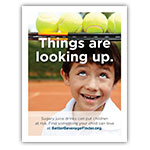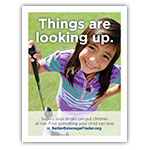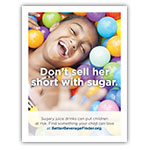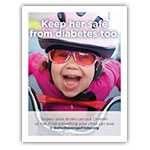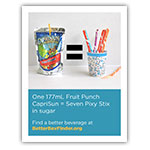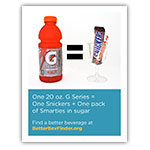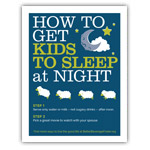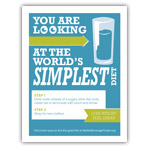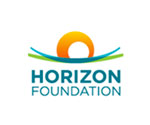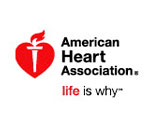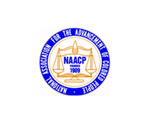Grab a Sugar Free Kids blurb to include in your next newsletter or blog. Choose from shorter (50 words) blurbs or longer (250 words) prewritten articles.
While the American Heart Association suggests that we consume no more than 9 teaspoons of sugar per day, 1 regular 20oz. soda contains 16 teaspoons of sugar. Think it’s time to rethink your drink? Then checkout BetterBevFinder.org.
Obesity rates have more than doubled in children and quadrupled in adolescents in the past 30 years. Reducing sugary drink consumption is a simple step you can take now to get your child on a path to a healthier future. To find better choices for your family checkout BetterBevFinder.org.
According to the World Health Organization, total deaths from diabetes are projected to rise by more than 50% in the next 10 years. Most notably, upper-middle income countries such as the U.S. are expected to see an increase of over 80%. Your drink matters! Switch it for a better one at BetterBevFinder.org.
Despite numerous alternatives, sugary drinks are everywhere - at kids’ parties, on the soccer field, and at home. With 1 in 3 Maryland children overweight or obese, reducing sugary drink consumption is an immediate step we can take to stay healthy. Checkout BetterBevFinder.org to find hundreds of better choices for your family!
Sugary drinks are a common sight at kids’ parties and even at school. With 1 in 3 children alive today predicted to develop diabetes in their lifetime, reducing sugary drink consumption is an immediate step we can take to prevent diabetes and keep our families healthy. Checkout BetterBevFinder.org to find hundreds of better choices!
We are all concerned with how the sugar and calories from sugary drinks affect children’s sleep and attention spans, cause cavities, and increase the potential for obesity and life-threatening diseases such as diabetes. Sugar Free Kids is making it easier for parents to switch to better beverages and keep their families healthy. Visit BetterBevFinder.org to find out how!
Encouraging your child to choose water over sugary drinks might not be as hard a task as you think. Try offering them spa water. It will make thirsty kids happy and may help them reach for water, not a sugary drink in the future. Find tips & tricks at BetterBevFinder.org.
Helping your child choose water over sugary drinks might be easier than you think. Make water the only self-serve drink available in your house and keep a water pitcher or water bottles toward the bottom of the refrigerator and encourage your kids to help themselves. Find more tips & tricks at BetterBevFinder.org.
If your child has a taste for sweet beverages, consider offering 100% juice diluted with water, or water with natural fruit flavors. Over time, add less juice or flavoring. Your child will gradually adjust to the taste. Visit BetterBevFinder.org to find more choices!
Want to know a simple way to encourage your child to choose water over sugary drinks? Keep offering water. Studies show it takes tasting something 10 times for taste buds to “decide” if they like a taste or not. Keep trying with water and other ‘kid-friendly’ drinks from BetterBevFinder.org and you may find your picky eater or drinker has a change of heart.
Make water fun with novelty ice trays or crazy straws. Using a colorful straw or adding ice in unique shapes like animals or stars can be all it takes to get your child excited about a tall glass of H2O. Find more ideas at BetterBevFinder.org.
While soda is easiest to blame in the sugary drink debate, it isn’t the only sugary problem. Some parents think fun flavors encourage their kids to drink milk but a recent study indicates there is no evidence that flavored milk increases milk intake among kids. Instead of loading up on the sweet stuff, try using BetterBeverageFinder.org to help you identify low-sugar choices for your kids.
It’s easy to forget that soda isn’t the only offender in the sugary drink debate, other beverages such as sports drinks, can have just as much sugar. Instead of loading up on the sweet stuff, try using BetterBeverageFinder.org to help you identify low-sugar choices for your kids.
Though soda is a common culprit in the sugary drink debate, some juices can have added sugars that are not suitable for kids. Instead of loading up on the sweet stuff, stick to small portions of 100% juice or use BetterBeverageFinder.org to help you identify other low-sugar options for your kids.
Don’t be fooled by the fancy name. Spa Water is simply chilled water with natural, sugar-free flavors. Lemon. Cucumber. Rosemary. Blueberries. Whatever is on hand can work. Try one fruit at a time, or double up. Find the recipe at BetterBevFinder.org.
To Rethink Your Drink, visit BetterBeverageFinder.org to sort through over 300 beverage options.
BetterBeverageFinder.org has dozens of choices a mom can love. Find the best beverages for your family and where to find them.
Leading contributor to obesity and diabetes = sugary drinks. Rethink Your Drink! at BetterBeverageFinder.org.
We work hard to set our kids up for happy, healthy lives, but it’s not always that simple. Visit BetterBeverageFinder.org to make it easier.
Things are looking up! Maryland is dumping sugary sports drinks, and the risks that can go along with them. Find something you and your kids can love. BetterBeverageFinder.org.
Sugary drinks are a leading contributor to type 2 diabetes, which now affects children as young as 10. Use BetterBeverageFinder.org to find low-sugar drinks that you and your kids can love.
Children who drink at least one sugary drink a day are 55% more likely to be overweight or obese. Find low-sugar drinks your kids can love at BetterBevFinder.org.
Reducing sugary drink consumption can lead to better weight control among children and adults who are initially overweight. Rethink Your Drink! At BetterBevFinder.org.
Five Ways to Get Your Child to Choose WaterEncouraging your child to choose water over sugary drinks can be a tough sell, but these five ideas can help you make water a more popular choice for your kids. | Download |
Celebrating Without Sugary DrinksIt can be tempting to use sugary drinks as rewards for good behavior, hard work at school, completing chores at home, etc., and to tell kids that soda is only for special occasions. But saving soda for celebrations can actually work against you: it can make sugary drinks more appealing, and your kids may come to expect it as a treat. | Download |
Why We Choose Better BeveragesDespite numerous alternatives, sugary drinks are everywhere. At parties, youth sporting events, and even at school. | Download |
Dump the Sugar!The next time you’re ready to clean your house from top to bottom, tackle the pantries and fridges to dump the sugar! | Download |
Experimenting with Making Spa WaterDon’t be fooled by the fancy name. Spa water is simply chilled water with natural, sugar-free flavors. Lemon. Cucumber. Rosemary. Blueberries. Whatever is on hand can work. | Download |
How to Read Between the Lines: Drink labelsAnything that comes with fine print is worth investigating. Especially if it’s something you’re going to eat or drink. Here’s how. | Download |
A sugar-sweetened beverage (i.e. sugary drink) is a drink with sugar added. Sugar has many names. To find out if a drink contains sugar, look for any of these words on the list of ingredients: sugar, high-fructose corn syrup, brown sugar, corn sweetener, corn syrup, dextrose, fruit juice concentrates, glucose, honey, invert sugar, molasses, sucrose, syrup or cane sugar.
Sugary drinks are the greatest source of added sugars in the American diet and the #1 source of calories in teens’ diets.
Children and youth in the US averaged 224 calories per day from sugary beverages in 1999 to 2004—nearly 11% of their daily calorie intake.
Sugary drinks (soda, energy, sports drinks) are the top calorie source in teens’ diets (226 calories per day), beating out pizza (213 calories per day).
When you consume sugary drinks, you do not feel as full as if you had eaten the same calories from solid food, and you do not compensate by eating less.
Sugary drink consumption increases the risk of obesity, diabetes, heart disease, and gout.
Information on sugary drink packages may confuse people. Some fruit drink packages are covered with images of real fruit, even though these drinks may contain no more than 5% real fruit juice.
Parents believe that full-sugar soda is not a healthy option for their children, but they are under the impression that children’s fruit drinks are healthier. The truth is that ounce-for-ounce, the fruit drinks are just as high in calories and added sugar as soda.
A typical 20-ounce soda contains 15 to 18 teaspoons of sugar and upwards of 240 calories.
A 64-ounce fountain cola drink could have up to 700 calories.
In the 1970s, sugary drinks made up about 4% of US daily calorie intake; by 2001, that had risen to about 9%.
Studies in children and adults have found that reducing sugary drink consumption can lead to better weight control among those who are initially overweight.
If you were to drink one sugary soft drink every day, and not cut calories anywhere else in your diet, you could gain 15 pounds per year.
Young people are targeted through product placements and sponsorships. Sixty-three percent of all full-calorie soda and energy drink ads on national TV included sponsorship of an athlete, sports league or team, or an event or cause.
Highly caffeinated drinks, such as energy drinks, are not recommended for children and teens, yet they are heavily marketed to them.
A 2010 study found that each year, children and teens watch an average of 277 ads on sugary drinks and preschoolers watch about 213.
In 2010, teens viewed 12% more ads on TV for sugary drinks and energy drinks compared with adults, even though they watched fewer hours of TV.
Sugary drinks companies place online banner ads for their products on youth websites like Nickelodeon, Disney, and the Cartoon Network. Contests, games, and activities are often embedded in the ads to attract children.
Sugary drink advertising also reaches teens on their cell phones through banner ads on mobile websites, Smartphone applications, and text messaging ads.
The average can of sugary soda has the equivalent of 10 teaspoons of sugar.
Nationwide, 70% of children ages 2-5 years old consume at least one sugary drink on any given day.
Unless current trends are reversed, 1 in 3 U.S. children born after the year 2000 will develop type-2 diabetes in their lifetime.
Share our pictures in your newsletters, bulletins, emails, or website. Share them wherever you wish to include a little love for the health of Maryland kids!












